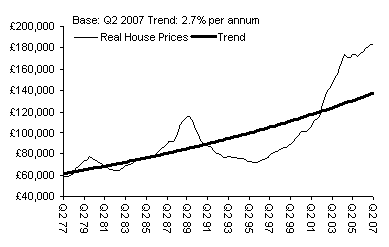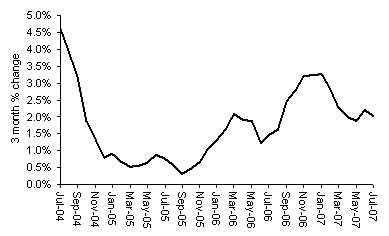Brakes slammed on house prices in July
- House price growth stalled in July, bringing annual growth back down into single digits
- A rise in interest rates to 6% is firmly on the horizon, but weak household income growth and mortgage payment shocks highlight the risk of monetary overkill
- The Housing Green Paper is a welcome step on housing supply but, as the recent flooding shows, the challenges ahead are substantial
Headlines |
July 2007 |
June 2007 |
Monthly index* Q1 '93 = 100 |
363.5 |
363.2 |
Monthly change* |
0.1% |
1.1% |
Annual change |
9.9% |
11.1% |
Average price |
£184,270 |
£184,070 |
* seasonally adjusted
Commenting on the figures Fionnuala Earley, Nationwide's Chief Economist, said:
“After surprisingly picking up steam in June, house prices were almost unchanged in July, and their underlying trend growth resumed a downward path.
“House prices managed a seasonally adjusted gain of only 0.1% in July, the slowest pace of growth since April 2006. The marked slowdown brought the annual rate of house price inflation down to 9.9%, following three consecutive months of double-digit growth. A typical UK property cost an average of £184,270 in July, £16,537 more than one year ago. The three-month on three-month rate of growth – often a better indicator of the underlying trend of house price inflation – slowed to 2.0% and resumed the downward path that had been interrupted in June.
A close call for the MPC
Source: ONS
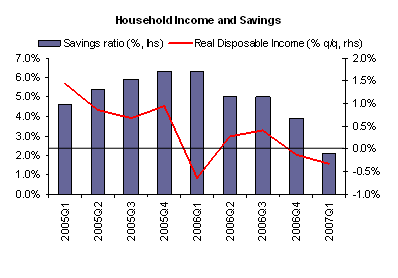 “The Bank of England now faces a tough balancing act in the months ahead, with tightening consumer finances on the one hand and resilient economic growth on the other. Fundamentals do suggest that household finances are coming under considerable pressure, and that house prices and consumer spending will both see a slowdown in the second half of the year. The sharp slowdown in July’s house price numbers could show that potential homebuyers are thinking twice about overstretching themselves in a higher interest rate environment. This makes sense in light of figures showing that real disposable incomes have fallen for two consecutive quarters - a result of higher retail price inflation, low earnings growth and higher net interest payments. In order to maintain spending growth, households have had to reduce the amount of money they put aside each month. As a result, the savings ratio has fallen to only 2.1% of disposable income, the lowest level since the 1960s.
“The Bank of England now faces a tough balancing act in the months ahead, with tightening consumer finances on the one hand and resilient economic growth on the other. Fundamentals do suggest that household finances are coming under considerable pressure, and that house prices and consumer spending will both see a slowdown in the second half of the year. The sharp slowdown in July’s house price numbers could show that potential homebuyers are thinking twice about overstretching themselves in a higher interest rate environment. This makes sense in light of figures showing that real disposable incomes have fallen for two consecutive quarters - a result of higher retail price inflation, low earnings growth and higher net interest payments. In order to maintain spending growth, households have had to reduce the amount of money they put aside each month. As a result, the savings ratio has fallen to only 2.1% of disposable income, the lowest level since the 1960s.
“Yet while a consumer slowdown later in the year seems likely, evidence of lower inflationary pressures has yet to emerge in the most recent economic data. Despite falling retail gas and electricity prices, inflation has failed to come down as quickly as expected and remained above the Bank of England’s target for the fourteenth consecutive month in June. To a certain extent, this could reflect volatile factors such as higher oil prices and large gains in furniture prices ahead of the summer discounting season. Other news showed that the economy shifted up a gear in the second quarter, growing slightly above its trend rate and adding to fears of tightening capacity pressures. With retail sales also having grown more quickly in the second quarter, there is as yet little evidence that the MPC’s tightening campaign has done much to cool the economy. This resilience gives some ammunition to the hawks on the committee and keeps the prospect of 6% interest rates on the horizon.
Past rate hikes are likely to bite more as fixed-rate deals expire
“As the MPC considers where to take monetary policy over the coming months, consideration will need to be given to the lagged impact of the 1.25 percentage points of tightening that has already taken place. Since the August 2005 rate cut, close to 70% of borrowers have taken out fixed-rate mortgages, with most of these deals lasting for 2-3 years. It is estimated that over the next 18 months, nearly two million borrowers will see their fixed rate deals expire, leaving them with the choice of reverting to the standard variable rate or re-mortgaging onto a new fixed rate deal or tracker mortgage. Most borrowers are likely to take the option of switching to a fixed rate, given that these are considerably below the standard variable rate.
Estimated payment shocks from refinancing a 2-year fixed rate repayment mortgage * |
||||||
|
Monthly Payment (75% loan to value ratio) |
|
Monthly Payment (95% loan to value ratio) |
|
||
|
August 2005 |
August 2007 |
|
August 2005 |
August 2007 |
|
Flat |
£483 |
£561 |
£78 |
£612 |
£710 |
£98 |
Terrace |
£553 |
£642 |
£89 |
£701 |
£814 |
£113 |
Semi-detached |
£661 |
£768 |
£107 |
£838 |
£973 |
£135 |
Detached |
£934 |
£1,084 |
£150 |
£1,183 |
£1,374 |
£191 |
Source: Nationwide calculations based on Bank of England effective mortgage rates.
* Assumes that borrower has a 25 year initial term in August 2005 and re-mortgages onto a new 2-year fixed rate mortgage upon expiration. Excludes the effects of re-mortgaging fees.
“A borrower looking to refinance a 2-year fixed rate mortgage from the mid-2005 to mid-2006 period is likely to bear nearly the full brunt of the MPC’s recent tightening in one go. For example, a homebuyer who bought a typical flat at a 75% loan-to-value ratio in August 2005 would see a £78 increase in monthly payments when re-mortgaging, excluding the effects of any fees. Assuming the borrower earns the UK average income, the payment shock from re-mortgaging would eat up about two thirds of the increase in monthly take-home pay that the individual has seen in the last two years. When the effects of inflation over this period are added, the squeeze on finances becomes even more acute and further highlights the risk of monetary overkill.
The Prime Minister’s recent housing initiative is a step in the right direction …
“Another focus of the past month has been the issue of housing supply. In a speech before Parliament, Gordon Brown announced eagerly anticipated plans to ease the acute housing shortfall existing in many parts of the UK. The slow response of the housing stock to demand has certainly been a distorting feature of the market in recent years and has contributed to putting home ownership out of reach for many first-time buyers. The government’s proposal to add 3 million homes to the housing supply by 2020 is therefore a welcome development.
… but the scale of the supply-side challenge is considerable
“Yet despite the announced proposals, potential homeowners hoping for a quick fix to the supply problem would be wise to manage their expectations. As the Department of Communities and Local Government’s Green Paper acknowledges, the current level of housing completions is 38,000 units behind the projected annual level of household formation. This implies that merely keeping the housing shortfall from deteriorating further will require a large step increase in the number of completions. Relieving supply-side pressures on house prices will therefore be a gradual process, with more significant effects in the medium to long term than in the immediate future. In addition, with limited land supplies available, careful choices need to be made about where to locate new homes. The recent floods are testimony to this and highlight the challenges to increasing the housing supply.”
Fionnuala Earley Katie Harper
Chief Economist Media Relations Manager
Tel: 01793 656370 Tel: 01793 656215
fionnuala.earley@nationwide.co.uk katie.harper@nationwide.co.uk
Average UK House Price
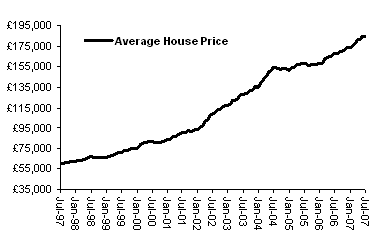
Long Term Real House Price Trend
3 months on previous 3 months % change
Annual % Change in House Prices
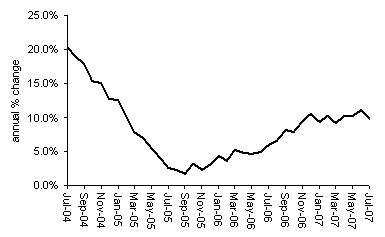
Historical Data

Notes:
Indices and average prices are produced using Nationwide's updated mix adjusted House Price Methodology which was introduced with effect from the first quarter of 1995. Price indices are seasonally adjusted using the US Bureau of the Census X12 method. Currently the calculations are based on a monthly data starting from January 1991. Figures are recalculated each month which may result in revisions to historical data.
The Nationwide Monthly House Price Index is prepared from information which we believe is collated with care, but no representation is made as to its accuracy or completeness. We reserve the right to vary our methodology and to edit or discontinue the whole or any part of the Index at any time, for regulatory or other reasons. Persons seeking to place reliance on the Index for their own or third party commercial purposes do so entirely at their own risk. All changes are nominal and do not allow for inflation.
Think carefully before securing other debts against your home, your home may be repossessed if you do not keep up repayments on your mortgage.
Go Direct.co.uk is a trading style for website purposes of Go Direct UK Ltd.
Go Financial Services is a trading style of Go Direct UK Ltd which is an appointed representative of Personal Touch Financial Services Ltd which is authorised and regulated by the Financial Conduct Authority. Registered in England & Wales Company 5703224. FCA Number 456600
We normally do not charge a fee for mortgage advice, however this is dependent on your circumstances. Our typical fee would be £349





